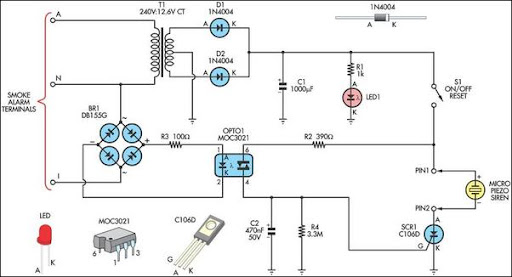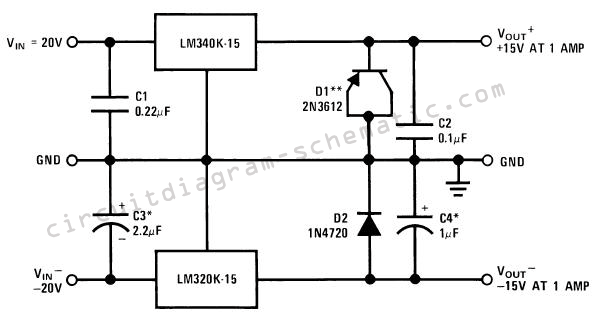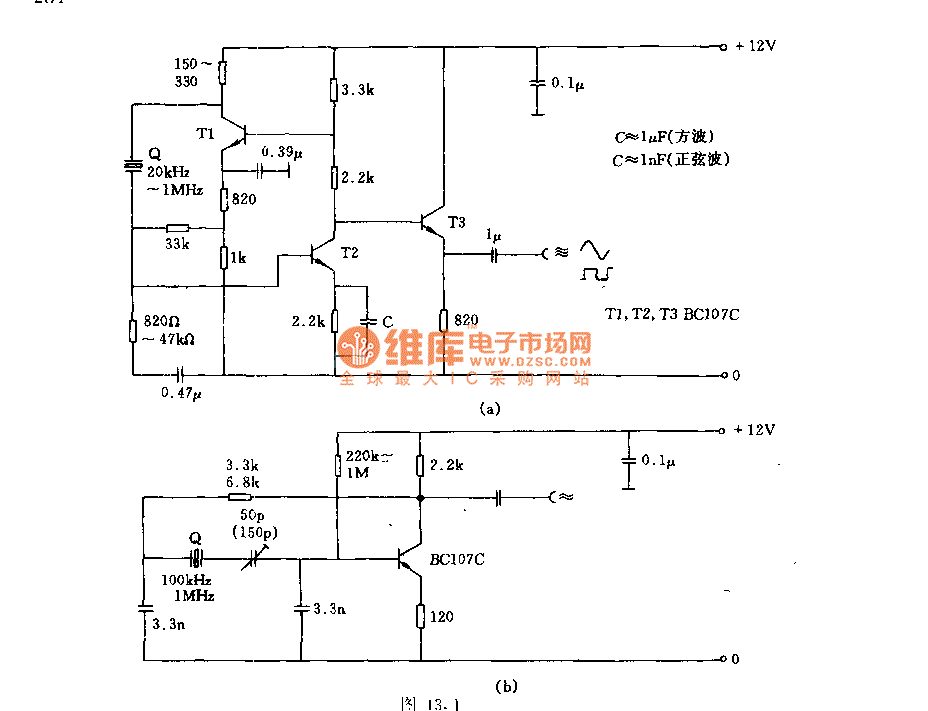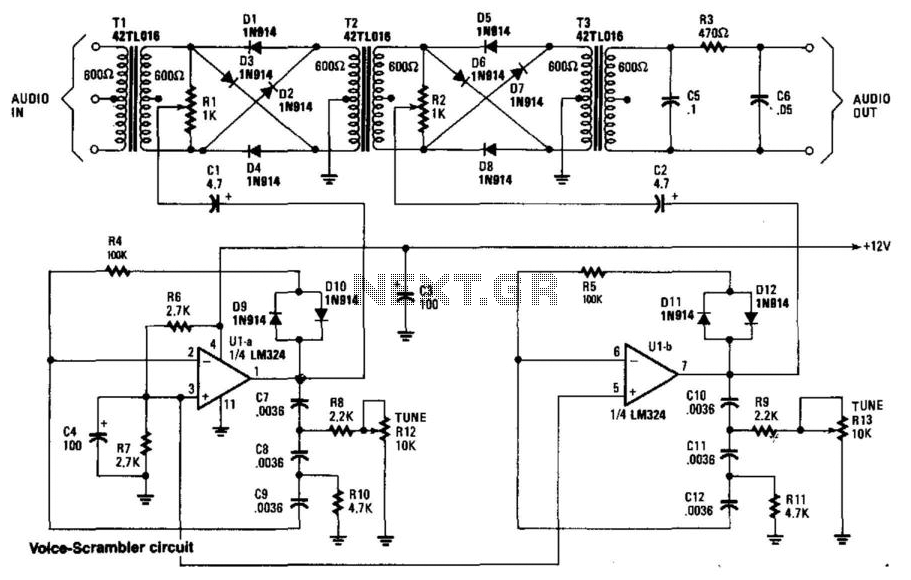
Circuit Detector and Disconnecting Over Voltage Schematic
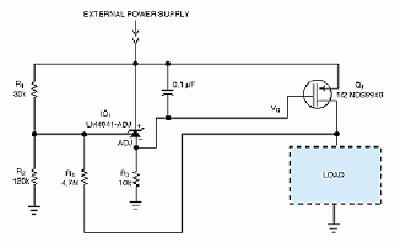
The circuit depicted is designed to protect a system from power supplies that may exceed safe limits. An example of this is small consumer products that utilize external AC adapters, where there is a risk of accidentally connecting the wrong adapter. Another scenario involves portable systems that rely on rechargeable battery packs; if the battery pack is missing or fails to open during recharging, a high-compliance charger could supply excessive voltages to the system. The circuit employs the LM4041 adjustable shunt-voltage regulator as a voltage detector. When functioning as a reference, the LM4041 generates a voltage across its positive and negative terminals, causing the voltage across resistor R1 to equal 1.24V. However, resistor R3 inhibits this servo action. With R3 included in the circuit, the voltage VG remains close to ground when the voltage across R1 is less than 1.24V and is approximately 1V below the positive rail when the voltage across R1 exceeds 1.24V. Consequently, a threshold voltage can be established by selecting suitable values for resistors R1 and R2. When the supply voltage surpasses this threshold, VG increases, turning off transistor Q1 and disconnecting power from the load. The values of R1 and R2 should be chosen such that VSHUTOFF corresponds to the supply voltage that triggers the shutoff. With the specified values, the circuit disconnects power from the load when the supply voltage reaches roughly 6V. Resistor R4 introduces hysteresis to prevent oscillation when the supply voltage hovers near the shutoff threshold. The integrated circuit (IC1) can handle shutoff voltages up to 10V; by clamping the supply voltage of IC1 with an additional inexpensive shunt reference or Zener diode across its positive and negative terminals, higher maximum shutoff voltages can be achieved. The maximum supply voltage with the selected components is approximately 50V.
This circuit serves as an essential safeguard for electronic devices, particularly those vulnerable to voltage fluctuations from external power sources. The use of the LM4041 as a voltage reference ensures precise detection of voltage levels, allowing for reliable operation under varying conditions. The careful selection of resistors R1 and R2 is crucial, as these components define the voltage threshold for system shutdown. By implementing R3, the circuit maintains stability and prevents unnecessary interruptions caused by minor voltage variations.
The inclusion of resistor R4 is a strategic design choice, providing hysteresis to the system. This feature is vital in applications where the supply voltage might fluctuate around the shutoff threshold, as it prevents rapid on-off cycling that could lead to potential damage or operational instability. The design also accommodates a wide range of supply voltages, making it versatile for various applications.
In summary, this protection circuit is an effective solution for managing power supply risks in consumer electronics and portable devices, ensuring that they operate within safe voltage limits while maintaining functionality and reliability.The circuit in this figure is protecting the circuit and the system with power supplies that may exceed safe limits. One example is small consumer products that use external ac adapters; its easy to mistakenly plug in the wrong adapter.
Another example is a portable system that uses a rechargeable battery pack. If the battery pack is absent or fai ls to open during recharging, a high-compliance charger can deliver excessive voltages to the system. The circuit works using LM4041 adjustable shunt-voltage regulator as a voltage detector. When it operates as a reference, the LM4041 develops a voltage across its positive and negative terminals.
This signal forces the voltage across R1 to equal 1. 24V. In this circuit, however, R3 prevents this servo action. With R3 in the circuit, VG is near ground when the voltage across R1 is less than 1. 24V, and VG is approximately 1V below the positive rail when the voltage across R1 is greater than 1. 24V. You can, therefore, set a threshold voltage by selecting appropriate values of R1 and R2. When the supply voltage exceeds the threshold, VG goes high, thereby turning off Q1 and removing power from the load.
Select R1 and R2 according to: It where VSHUTOFF is the supply voltage that causes shutoff. With the values shown, the circuit removes power from the load when the supply voltage reaches approximately 6V. R4 provides hysteresis to prevent chattering when the supply voltage is near the shutoff value. IC1 can accommodate shutoff voltages as high as 10V; clamping IC1s supply voltage with another inexpensive shunt reference or zener diode (across the positive and negative terminals) allows higher maximum shutoff voltages.
Maximum supply voltage with the components is approximately 50V. 🔗 External reference
This circuit serves as an essential safeguard for electronic devices, particularly those vulnerable to voltage fluctuations from external power sources. The use of the LM4041 as a voltage reference ensures precise detection of voltage levels, allowing for reliable operation under varying conditions. The careful selection of resistors R1 and R2 is crucial, as these components define the voltage threshold for system shutdown. By implementing R3, the circuit maintains stability and prevents unnecessary interruptions caused by minor voltage variations.
The inclusion of resistor R4 is a strategic design choice, providing hysteresis to the system. This feature is vital in applications where the supply voltage might fluctuate around the shutoff threshold, as it prevents rapid on-off cycling that could lead to potential damage or operational instability. The design also accommodates a wide range of supply voltages, making it versatile for various applications.
In summary, this protection circuit is an effective solution for managing power supply risks in consumer electronics and portable devices, ensuring that they operate within safe voltage limits while maintaining functionality and reliability.The circuit in this figure is protecting the circuit and the system with power supplies that may exceed safe limits. One example is small consumer products that use external ac adapters; its easy to mistakenly plug in the wrong adapter.
Another example is a portable system that uses a rechargeable battery pack. If the battery pack is absent or fai ls to open during recharging, a high-compliance charger can deliver excessive voltages to the system. The circuit works using LM4041 adjustable shunt-voltage regulator as a voltage detector. When it operates as a reference, the LM4041 develops a voltage across its positive and negative terminals.
This signal forces the voltage across R1 to equal 1. 24V. In this circuit, however, R3 prevents this servo action. With R3 in the circuit, VG is near ground when the voltage across R1 is less than 1. 24V, and VG is approximately 1V below the positive rail when the voltage across R1 is greater than 1. 24V. You can, therefore, set a threshold voltage by selecting appropriate values of R1 and R2. When the supply voltage exceeds the threshold, VG goes high, thereby turning off Q1 and removing power from the load.
Select R1 and R2 according to: It where VSHUTOFF is the supply voltage that causes shutoff. With the values shown, the circuit removes power from the load when the supply voltage reaches approximately 6V. R4 provides hysteresis to prevent chattering when the supply voltage is near the shutoff value. IC1 can accommodate shutoff voltages as high as 10V; clamping IC1s supply voltage with another inexpensive shunt reference or zener diode (across the positive and negative terminals) allows higher maximum shutoff voltages.
Maximum supply voltage with the components is approximately 50V. 🔗 External reference
